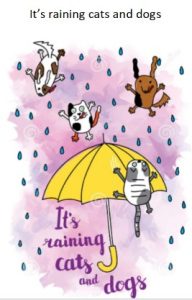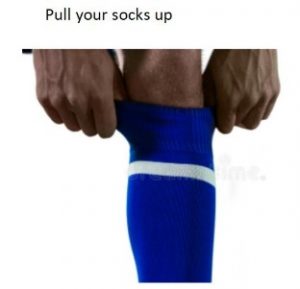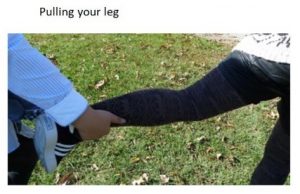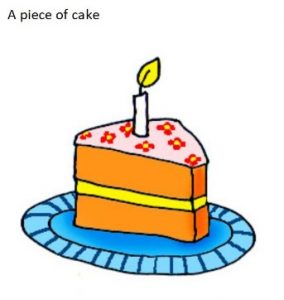DLP'S BIG IDEAS
At Eastwards Consortium, our focus is primarily on educating and developing the next generation of our society. To assist in this, we use our well-known ‘Big Book of Ideas’, a set of activities and tasks focused around pupil development.
Below you will find a set of tabs which depict these tasks further. If you find children are struggling with a task or, on the other hand, passing with flying colours, indications and suggestions are proposed in each section to ensure you keep all children challenged and on-task as much as possible.
To view these sections, simply click on the respective tab and watch it magically appear!
BEING ABLE TO RECALL THE DAYS OF THE WEEK IN ORDER
MAIN ACTIVITY
- Look at a calendar or diary together. Look at the days of the week. Read them aloud together and then ask your child to repeat them on their own.
- If there is space on the calendar/diary then this activity can be completed directly onto the page. If not, draw a chart on a blank piece of paper like this and write the names of the days of the week on the top row. Ask your child to help you write the names or say them aloud as you write. Colour Monday to Friday in one colour and Saturday and Sunday in another colour to separate the weekdays from the weekend:

- Ask the child to draw a picture of something they do each day in the relevant box. For example swimming, visiting grandparents or going to football practice (see above).
- Talk about the pictures and link this to the day of the week. For example, ‘What do you do on Monday? Which day comes after Monday?’ Prompt the child by saying this is the day you go to football practice. Model the sentence ‘The day after Monday is Tuesday’ and get your child to repeat. Repeat this activity with the different days of the week.
- Throughout the week talk to your child about different activities they are doing and relate it to days of the week. For example ‘Today is Friday, so tomorrow is Saturday and it is the weekend. On Saturday we will go and see nan and the next day we will go the park. Which day is that? Which day comes after Saturday?’ Have similar chats daily.
HOW CAN WE MAKE THIS ACTIVITY MORE CHALLENGING?
- Add an extra row to the chart above and separate activities into morning and afternoon. Link your chat to this, for example talk about what you do on Thursday afternoons and the next day on Friday morning.
- Talk about the day before and the day after.
- Write the days of the week on card and put them into the correct order.
- Link to dates and months of the year.
HOW CAN WE MAKE THIS ACTIVITY EASIER?
- Practise saying the days of the week in order.
- Look on Youtube for songs linked to days of their week:
- When you ask a question, give the child a choice e.g. ‘Does Tuesday or Wednesday come after Monday?’
ADDITIONAL IDEAS
Purchase a magnetic calendar:
Amazon.co.uk/First-Calendar-Magnetic-Hanging 42x35cm/dp/B08125GKFC/ref=psdc_ 364115031_t3_B000QGHPQA £12.99
https://www.argos.co.uk/product/2072689 £17.00
LINKS
https://www.verywellfamily.com/teaching-days-of-the-week-2764894
UNDERSTAND PASSIVE SENTENCES
MAIN ACTIVITY
- Collect some dolls (or similar) and everyday objects. For example; Barbie, Teddy, Buzz Lightyear, brush, cup, play food and ball.
- Give the child an instruction and ask them to act it out. For example:
i. Teddy is brushed by Buzz Lightyear.
ii. Barbie is fed pizza by Teddy.
iii. The ball is kicked by Barbie.
HOW CAN WE MAKE THIS ACTIVITY MORE CHALLENGING?
- Have lots of toys and objects for your child to choose from
- Ask your child to give you the instructions.
- During every day activities ask your child to finish your sentences e.g. ‘The ball is caught…’ and the child replies, ‘By Hassan’.
HOW CAN I MAKE THE ACTIVITY EASIER?
- Model the sentence and the action to your child and get your child to copy you.
- Repeat the sentence several times.
- Give the child the items and then say the sentence. For example, give them the Teddy, Buzz Lightyear and the brush and say ‘Teddy is brushed by Buzz Lightyear’.
- During every day activities model the sentences, for example when you are in the park say, ‘The swing is being played on by the girl’, ‘The ball is kicked by the boy’.
ADDITIONAL ACTIVITIES
Additional activities:
Use small world toys e.g. farm toys and ask your child to act out sentences such as. ‘The pig is chased by the cow’ and ‘The barn is slept in by the sheep’.
Songs & films:
IDENTIFY A RANGE OF EMOTIONS
MAIN ACTIVITY
- When reading your daily bedtime story with your child, look at the pictures and ask questions about how the characters are feeling. For example, in Goldilocks and the Three Bears when Goldilocks breaks the chair ask the child, ‘How is she feeling?’. Repeat for different points in the story, for example when the bears come home.
- When your child is playing a role play game at home e.g. shops or doctors, pretend to be an annoyed customer of a very poorly patient. Ask the child to guess how you are feeling based on your gestures, expressions and actions.
HOW CAN WE MAKE THIS ACTIVITY MORE CHALLENGING?
- Ask your child to act out different feelings.
- Make the emotions more complex, for example, caring, jealous or thoughtful.
- Extend understanding by asking ‘Why did Goldilocks feel like that? How do you know?’
- Use more complicated pictures in story books and ask questions where the answer isn’t immediately obvious. For example, in ‘We’re Going on a Bear Hunt’ ask ‘Why is the brother holding the baby like that?’ Draw out understanding of emotions such as the baby is excited to splash in the water but the brother is worried that he will fall in and he cannot swim.

HOW CAN WE MAKE THIS ACTIVITY EASIER?
- Use very simple pictures in the story book with just the main character. For example, with this picture you would ask ‘How is the girl feeling?’ You could also act it out with a toy and encourage your child to do the same:

– Use emotions that are easy to guess e.g. happy, sad, cross.
– Make facial expressions, gestures and actions more exaggerated so that they are easier to guess.
ADDITIONAL ACTIVITIES
Use the story ‘The Colour Monster’ by Anna Llenas. It can be borrowed from the library, purchased or found on Youtube
https://www.youtube.com/watch?v=Ih0iu80u04Y :
1. Read the story together and pause each time an emotion is revealed. Talk about what the emotion is, the colour and the shape.
2. Get your child to design their own monsters. Choose an emotion – what colour will they choose? What shape? Why have they made those choices? These could be drawn or created using playdough.
3. Use paint or food colouring and water and see what new colours your child can make. What feelings link with that colour?
Watch the film ‘Inside Out’. Discuss each emotion, their colour and how they behave.
UNDERSTANDING IDIOMS
MAIN ACTIVITY
-
- Choose one of the cards below and talk about what the child thinks it means. You can use the idiom in a sentence and get your child to help you think up different examples. For example, for ‘pull your socks up’:
- Ahmed hadn’t finished his story so the teacher said “Pull your socks up Ahmed, you have 10 minutes to finish!”
- Aisha was taking too long to eat her breakfast, so her mum said, “Pull your socks up Aisha or we will be late for school!”
- Use as many idioms as you can in your conversations with your child and talk about what they mean.
HOW CAN WE MAKE THIS ACTIVITY MORE CHALLENGING?
- Encourage your child to use idioms when they are speaking. For example, if you were reading a book together, you might ask how one of the characters was feeling. You might describe a clumsy characters as ‘like a bull in a china shop’.
HOW CAN WE MAKE THIS ACTIVITY EASIER?
- Focus on one idiom at a time and use it daily until the child can use it independently.
Some common idioms:
| Idiom | Meaning |
| Don’t cry over spilt milk | Don’t get upset over something you can’t change |
| It’s raining cats and dogs | Raining heavily |
| Pull your socks up | Try harder |
| Feeling under the weather | Feeling poorly |
| Pulling your leg | Playing a joke on someone |
| A piece of cake | Easy |
| Cool as a cucumber | Very calm |
| A rip off | Too expensive |
| As easy as ABC | Very easy |
| Draw a blank | Can’t remember |
| Get a kick out of it | Really enjoy something |
| Get your act together | Behave properly |
| Have mixed feelings | Unsure of something |
| In the same boat | In the same situation |
| Out of the blue | Without warning |
| Pass with flying colours | To achieve something easily |
| Read between the lines | Understand the real meaning |
| Cross your fingers | Wish good luck |
| Fell on deaf ears | People wouldn’t listen |
| Get cold feet | Feel nervous |
| A bull in a china shop | Being clumsy |
| Hold your horses | Wait a minute |
Visit this website for more:
https://examples.yourdictionary.com/idioms-for-kids.html
https://www.theidioms.com/kids/
Films to help:
https://www.youtube.com/watch?v=VdKK4gWFO0c&t=176s
https://www.youtube.com/watch?v=_s_CH4yXXHQ
https://www.youtube.com/watch?v=d63MKHE6MQA&t=1s
https://www.youtube.com/watch?v=YcPdU9HVDtk
Stories to help:
Butterflies in my Stomach by Serge Bloch
https://www.youtube.com/watch?v=8-PHM_IM67E
More Parts by Tedd Arnold
https://www.youtube.com/watch?v=OSwm8hdHnXQ
My Teacher Likes to Say by Denise Wilson
https://www.youtube.com/watch?v=zRUqB4wDOmk






PREDICTING WHAT MIGHT HAPPEN NEXT
MAIN ACTIVITY
- Read any story together. Join your local library for free and you will be able to borrow up to 10 books at a time.
- Read the first few pages together. At key places, stop and ask ‘What will happen next?’
- If your child is unsure ask more supportive questions. For example, if you are reading ‘Red Riding Hood’ you might ask ‘Whose house is Little Red Riding Hood going to? Who might she find when she gets there?’
HOW CAN WE MAKE THIS ACTIVITY MORE CHALLENGING?
- When you read on and find the answer to what happens next, talk about what else could have happened. Ask what the child would have done if they were that character.
HOW CAN WE MAKE THIS ACTIVITY EASIER?
- Offer choices instead of asking ‘What will happen next?’ For example, ask ‘Is Little Red Riding Hood going to visit Grandma’s house or the Woodcutter’s house?’
- Use toys to act out different scenarios. For example, sit Teddy by a book or some toy food. Ask ‘What will Teddy do next?’
UNDERSTANDING PERIODS OF TIME
MAIN ACTIVITY
-
-
-
-
- Use songs on Youtube to help you practise the days of the week together:
https://www.youtube.com/watch?v=8GKmCQOy88Y
https://www.youtube.com/watch?v=mXMofxtDPUQ
https://www.youtube.com/watch?v=bLdFvCJNtOk
- Create a weekly calendar for yourself, like the one below
 Fill in the activities you are going to do in the week and regularly discuss what you are planning to do. Use the names of the days of the week in your discussions, as well as talking about what happened yesterday and what will happen tomorrow.
Fill in the activities you are going to do in the week and regularly discuss what you are planning to do. Use the names of the days of the week in your discussions, as well as talking about what happened yesterday and what will happen tomorrow. - Don’t forget to emphasise week/school days for Monday to Friday and Saturday and Sunday being the weekend.
-
-
-
HOW CAN WE MAKE THIS ACTIVITY MORE CHALLENGING?
- In your discussions use more time conjunctions such as yesterday, last weekend, later today, this evening, tomorrow, next week, at the weekend and during the holidays.
- Listen and sing Youtube songs linked to months of the year:
https://www.youtube.com/watch?v=Fe9bnYRzFvk
https://www.youtube.com/watch?v=SSl-SbVz2oA
https://www.youtube.com/watch?v=v608v42dKeI
- Purchase a permanent calendar such as:
https://www.argos.co.uk/product/2072689?clickPR=plp:58:89
This can be used to link in with the seasons, the weather and
key events such as Eid, Christmas and Mother’s Day.

HOW CAN WE MAKE THIS ACTIVITY EASIER?
- Add photos to the calendar for each event to support for those who find reading more challenging.
- Have real objects, such as a towel for swimming or a ball for football practice to prompt the discussions.
REMEMBERING MORE AND MORE INFORMATION
MAIN ACTIVITY
- Memory games are brilliant for this! Start your sentence ‘In my bag I packed a book’. Your child then needs to continue by saying ‘In my bag I packed a book and a teddy’. The next person then says ‘In my bag I packed a book, a teddy and a hat’. Keep going until someone forgets!
- Kim’s Game – Place some household items onto a tray (the more items, the more challenging the game so just start with just 3-4 items and increase from there).
Tell your child to have a close look at the items on the tray. Name them together (the more you discuss the items the more likely your child is to remember them so you could ask them what colour or shape each item is or what it is used for).
Cover the items with a tea towel. Ask your child to close their eyes and as they do so remove one item from under the cloth.
Ask them to open their eyes, remove the cloth and tell you what’s missing!
- Variation on Kim’s Game – use more items and allow them to look at them for a full minute. Then cover them up and ask them to write a list or draw as many of the items that they can remember.
Check out https://childhood101.com/short-term-memory-games/ for more ideas.
HOW CAN WE MAKE THIS ACTIVITY MORE CHALLENGING?
- The items in the list must start with the letters of the alphabet in order.
- All items must begin with the same sound e.g. ball, bat, bell
HOW CAN WE MAKE THIS ACTIVITY EASIER?
- Have a group of pictures laid face down. The pictures could be cut from a magazine if you do not have any other suitable ones from another game. Start with turning each one over so they children have a picture to look at to remind them. Move onto to just having a brief look at the card before putting it face down again. The child will know how many items they need to remember but they won’t have the pictures. They can always have another peek if they get stuck!
- Play the game without any other distractions, such as the TV or radio. We all find it easier to concentrate when it is quiet.
ORGANISING OBJECTS
MAIN ACTIVITY
- Collect some items of clothing, food and toys (they need to be similar things, for example animals from a farm set). Choose three items e.g. sock, vest and jumper. Two things must have something in common (sock and vest are both underwear) and the other should be different.
- Put out the objects and ask, ‘What group do these all belong to?’ Next ask which go together best and why. Finally, ask what is different about the other item (e.g. it is warm clothing and would be worn in winter).
- Repeat this with different items.
HOW CAN WE MAKE THIS ACTIVITY MORE CHALLENGING?
- Ask the child to find more objects round the house that would go with the sock and vest.
- Choose items that have more similarities so it is harder to find a difference e.g. cereal, toast, porridge – all are food eaten at breakfast. You can discuss several answers and ways of organising. For example, cereal and porridge have milk on them, toast is made from bread.
HOW CAN WE MAKE THIS ACTIVITY EASIER?
- If your child is finding it difficult to work out which group the items belong to, ask ‘Are these clothes or animals?’
- Choose two items from one group and one from another e.g. sock, vest and cereal. Keep repeating the category names (food & clothing) so that the child learns the vocabulary.
ADDITIONAL ACTIVITIES
- Collect different animal toys and organize them into different groups e.g. farm and zoo animals, land and sea animals etc.
MAKING INFERENCES USING IDIOMS
MAIN ACTIVITY
Show the child the following picture:

- Ask the child: ‘The man and woman are getting wet in the rain because it’s raining cats and dogs.’
- Ask the child: ‘Is it really raining cats and dogs?’
- Explain the meaning of idioms to the child: words that sometimes mean another thing.
- Explain to the child that you said that it is raining cats and dogs because the rain was very heavy.
HOW CAN WE MAKE THIS ACTIVITY MORE CHALLENGING?
- Read a book with the child and try to identify the idioms.
HOW CAN WE MAKE THIS ACTIVITY EASIER?
- Slow down the rate of delivery to support the child’s processing.
ADDITIONAL ACTIVITIES
USING FUTURE TENSE TO DESCRIBE THINGS THAT WILL HAPPEN
MAIN ACTIVITY
- Ask the child to help you write a list before you go shopping.
- As you travel to the shop talk about what you will buy. Model the sentence ‘I’m going to buy…’ Ask your child to repeat the sentence with a different item. Repeat these sentences as you get to the shop and choose the items.
HOW CAN WE MAKE THIS ACTIVITY MORE CHALLENGING?
- On the way home discuss what has been bought. Model with the sentence ‘We went to the shops and we bought…’ Encourage the child to make up their own sentences.
- Use more complex language e.g. ‘I will buy’, ‘I shall buy’.
- Talk about things that will happen next week/month.
HOW CAN WE MAKE THIS ACTIVITY EASIER?
- Model the sentences that you expect and get your child to copy you.
- Draw pictures on your list to prompt your child.
ADDITIONAL ACTIVITIES
- As you put your child to bed at night you can talk about what you will do the next day. For example – ‘Tomorrow we will go to Nanna’s house’.
- When you are going on holiday, talk about what you are planning to do.
- Play this simple game – all you need is an empty bag. The first person has the bag and thinks of something that could be in it, for example a ‘kitten’. The second person asks, ‘Why do you have a kitten in your bag?’ The first person uses the future tense and answers ‘I am going to give it to my friend’.

